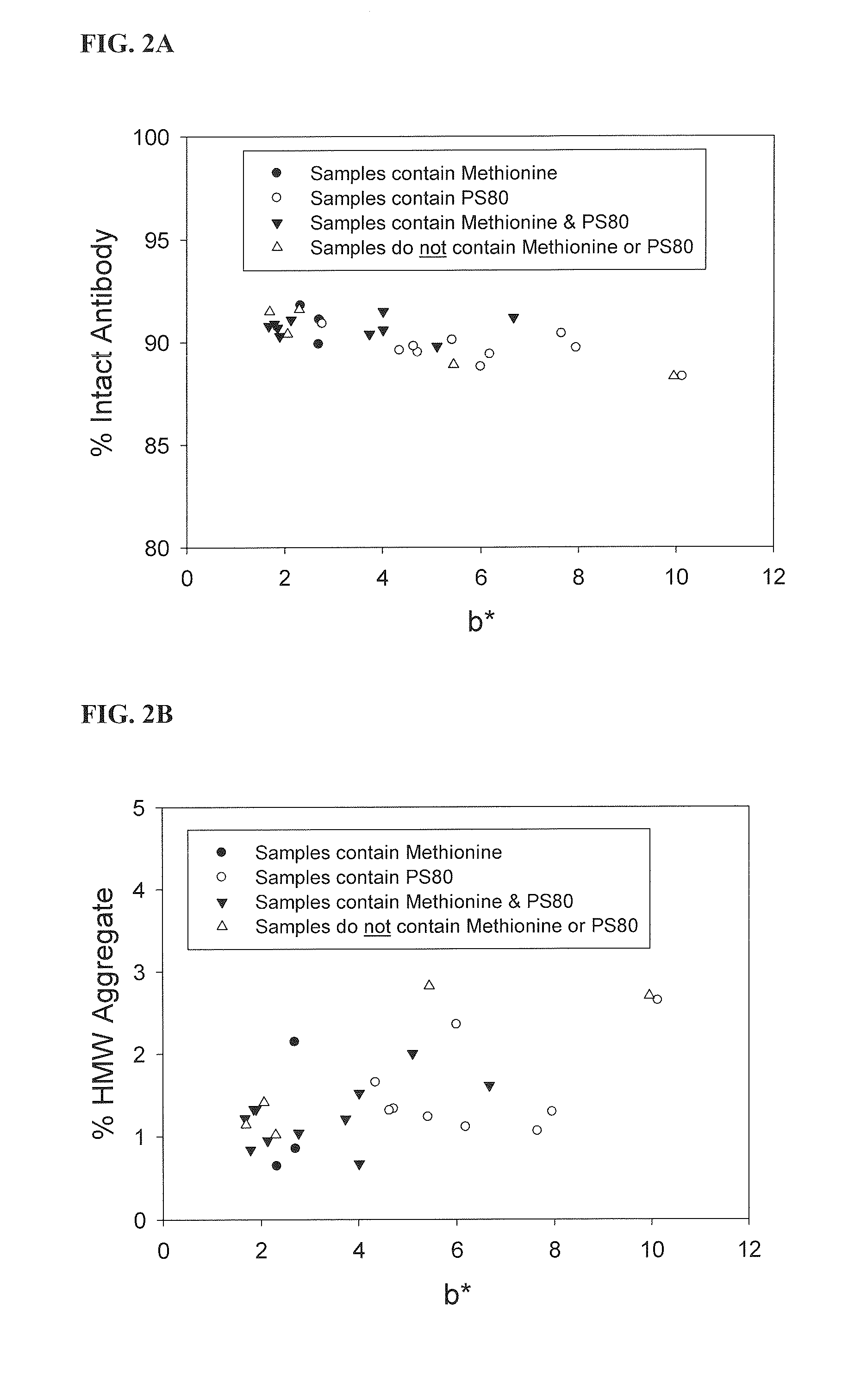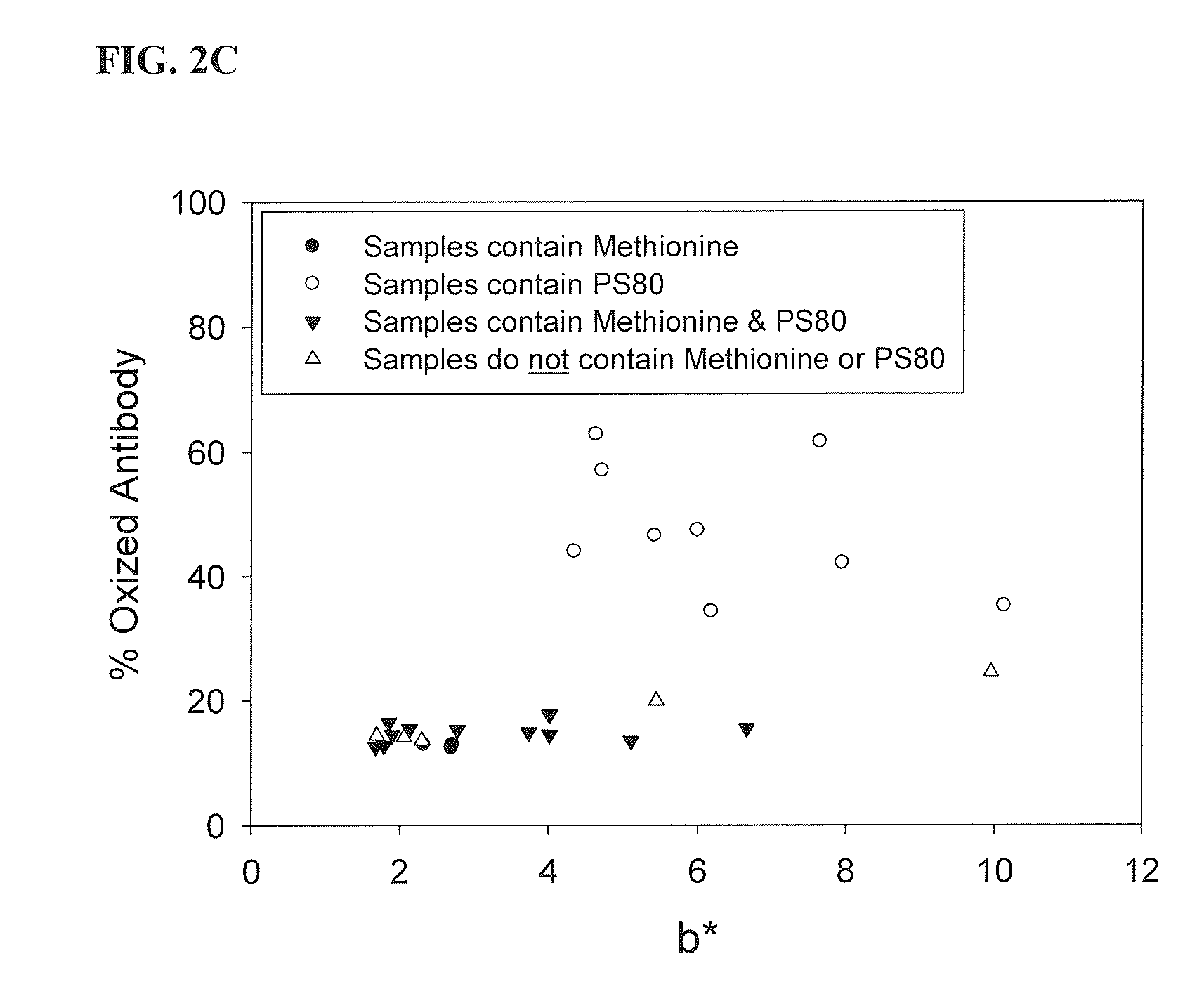Methods for Inhibiting Yellow Color Formation in a Composition
- Summary
- Abstract
- Description
- Claims
- Application Information
AI Technical Summary
Benefits of technology
Problems solved by technology
Method used
Image
Examples
example 1
A System for the Measurement of Yellow Color Formation Based on Yellow Color Standards
[0063]The HunterLab color system can be used to measure spectrophotometrically the degree of solution yellowing in a cuvette or in vials. EP color standards were created as described in section 2.2.2 of the European Pharmacopoeia “Degree of Coloration of Liquids”. The EP standard color stock solutions were purchased from Ricca Chemical Company. The Y and BY EP standards were measured using the HunterLab ColorQuest XE instrument both in a 1 cm path-length, quartz cuvette as well as in 10 mL glass vials. The b* color value was plotted against the fold-dilution used to create the color standards.
[0064]Analysis of the Y (squares) and BY (diamonds) EP color standards indicated a linear increase in b* values with increasingly yellow solutions up to b* values of 45 (FIG. 1A). Visual assessment of samples correlated well with b* values with the exception of very yellow samples where instrument linearity de...
example 2
Design of Experiments (DOE) Screen of Yellow Color Formation of Histidine Compositions Containing Common Excipients
[0065]In order to determine the effect of excipients and other formulation factors on the yellowing of any composition, screens can be designed by any number of methods, including statistical analysis programs. To test the effect of nine formulation factors on histidine yellowing, Design Expert 6.0.5 (Stat-Ease) was used to create a D-Optimal experimental design (see Table 1). The design included 55 formulations and had the statistical power to enable analysis of 2-factor interactions. Formulations were created using the following reagents: L-histidine (J. T. Baker), L-histidine monohydrochloride (J. T. Baker), sodium chloride (Sigma-Aldrich or Fisher Scientific), sucrose (high purity, low endotoxin, beet-derived from Ferro Pfanstiehl), L-methionine (Sigma), L-arginine hydrochloride (J. T. Baker), glycine (J. T. Baker), glycerol (J. T. Baker), polysorbate 80 (J. T. Bake...
example 3
Analysis of Product Quality in Relation to Yellow Color Formation
[0068]To determine whether yellow color formation of a histidine buffer affects the product quality of a typical monoclonal antibody (mAb) produced by Biogen Idec, samples of the mAb were incubated in histidine buffer comprising additional excipients. Other samples of the mAb were incubated in the same histidine buffer plus polysorbate 80, methionine, or polysorbate 80 and methionine. Intact antibody analysis was performed by LABCHIP® 90 gel chip analysis. High molecular weight aggregate analysis was performed by size exclusion chromatography using a TSK-GEL® G3000SWXL column and guard column from Tosoh Bioscience (0.1 M sodium phosphate / 0.2 M sodium chloride, pH 6.8 mobile phase, 0.5 mL / min flow rate, 60 minute separation with detection at 280 nm). Oxidized antibody was determined by LC-MS focused peptide map analysis.
[0069]As shown in FIG. 2, significant changes in solution color do not necessarily correlate to chang...
PUM
| Property | Measurement | Unit |
|---|---|---|
| Molar density | aaaaa | aaaaa |
| Molar density | aaaaa | aaaaa |
| Molar density | aaaaa | aaaaa |
Abstract
Description
Claims
Application Information
 Login to view more
Login to view more - R&D Engineer
- R&D Manager
- IP Professional
- Industry Leading Data Capabilities
- Powerful AI technology
- Patent DNA Extraction
Browse by: Latest US Patents, China's latest patents, Technical Efficacy Thesaurus, Application Domain, Technology Topic.
© 2024 PatSnap. All rights reserved.Legal|Privacy policy|Modern Slavery Act Transparency Statement|Sitemap



